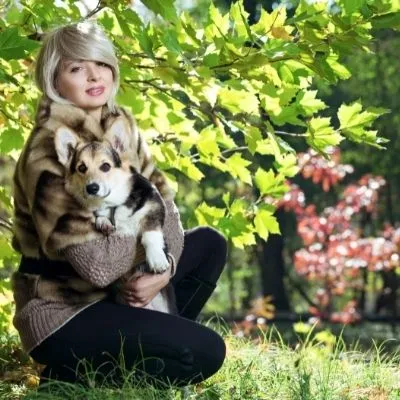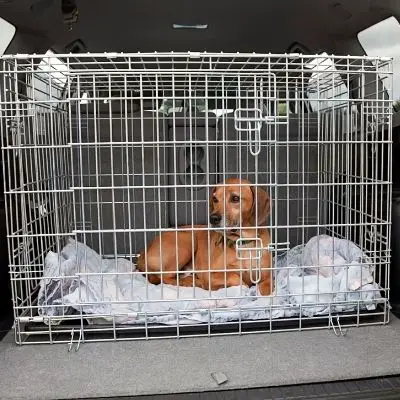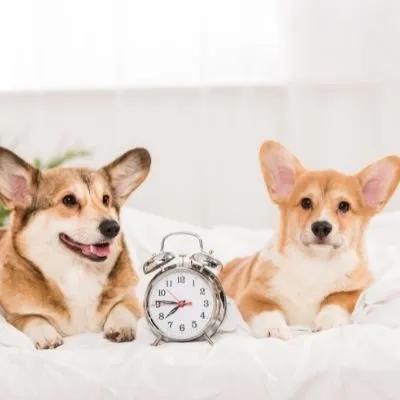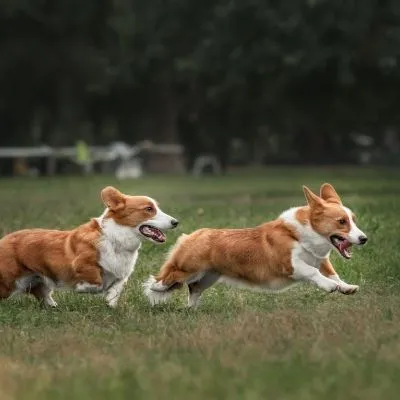Corgi puppies, particularly Pembroke Welsh corgi puppies, are among the most affectionate and intelligent breeds out there. However, these tiny dogs can also be mischievous and stubborn, making it difficult to train them.
To help you overcome this challenge, here’s an extensive guide on Pembroke Welsh corgi puppy training that covers everything from housebreaking to socialization skills to leash training to tricks and more!
How to Choose a Pembroke Welsh Corgi Puppy
There are a few things you should look for when choosing a puppy. First and foremost, Pembroke Welsh Corgis will be happy in any home as long as they get proper exercise, plenty of love and attention, and tons of toys!
If you have small children, keep in mind that they will probably not be very interested in cuddling with your pup until he is older. They also might accidentally step on him.
It is much easier to train a puppy if you can hire or borrow an older dog from a friend or family member who has already started his or her training—this way, your puppy won’t become confused about what to do around your older dog.
You could also try taking your new puppy to obedience classes at a local pet store or animal shelter. These classes usually start out with some basic commands such as sit and stay before moving on to more advanced ones like come and drop it.
Training takes time, but there are many great resources available online so you can continue working with your new pup even after class ends.
You may even want to consider starting a journal where you write down all of your daily activities (and anything else noteworthy) so that one day when he is grown up, you can read it back and remember how quickly he grew up!

Introducing your Puppy to its new home
The first week with your new puppy is a critical period for socialization and house training. You’ll want to give your new addition plenty of time and attention so he feels as though he’s part of your family from day one.
Make sure you spend lots of time getting him used to his crate, so he feels comfortable when it comes time for him to spend some alone time in it later on.
Socialize your puppy, too—he needs an abundance of people-time so that he feels comfortable around humans and non-canine animals later on.
Most importantly, be patient! Bringing home a new dog will be exciting at first, but don’t forget that you’ll have years ahead together as a companion—so relax!
Crate Training
The safest way to housetrain a dog is through crate training. If you’re not familiar with crate training, it’s a method of housebreaking in which your puppy lives in a small confined space, like a wire crate or kennel, while he learns not to soil his den (crate).
It’s important that you do not leave your puppy alone in his crate all day; during periods when you can’t actively supervise him, make sure he has plenty of safe toys and comfortable bedding.
Crate training takes some time and effort on your part—he will have accidents—but there are many advantages to using crates for housebreaking your dog. Most importantly, dogs who are crated while they’re young don’t develop separation anxiety later on.
When you’re ready to begin crate training, remember these tips: Don’t use a brand new crate. Your puppy will be more likely to soil his sleeping area if it smells like him.
Instead, use an old towel or blanket that belongs to your pup as a bedding material in his crate at first. You’ll want to get rid of any scents from other animals or previous owners too – rub down your pup’s new home with baking soda before introducing him inside.
And never use cages as punishment!

How To House Train A Puppy
The first two weeks of your puppy’s life are probably one of the most important times for your dog. This is how you lay down a solid foundation of habits and behaviors that will lead to a well-behaved adult dog.
However, it can be quite frustrating if your puppy doesn’t understand what it takes to follow house rules, like not going potty inside. Luckily, potty training isn’t as difficult as you might think.
With these tips from our expert trainers at PuppySpot, you’ll have your pup peeing outside in no time! Follow these simple steps, based on age and experience level, to train your Pembroke Welsh Corgi properly.
As soon as possible after getting your new Pembroke Welsh Corgi puppy home—but before taking him out into public—start training him with basic commands such as sit or down.
Although he may seem small and easy to handle now, Pembrokes grow quickly—in just six months he could weigh over 50 pounds! He should already know his name before bringing him home so make sure he responds when called (this way you won’t accidentally call another dog by his name).
If he does not respond then begin working on his name recognition with short training sessions daily.

How To Potty Train A Puppy Quickly And Easily
Here are our three golden rules for potty training a puppy: be consistent, be patient, and remember that your puppy will have accidents.
If you follow these rules, you’ll find your Pembroke Welsh Corgi puppy can be completely trained in one month or less. But there are lots of other tips and tricks you can use along with our golden rules! Keep reading to learn more about how to train a dog.
Toilet Training A Puppy With Separation Anxiety: Training a puppy with separation anxiety is difficult because they want to be near their owners at all times.
This means they’ll want to go outside when you’re gone but they won’t want to relieve themselves when left alone. To make things easier on both of you, try using pee pads instead of taking them outside every time.
When you leave your house for long periods of time (more than an hour), let them know by putting them on their pee pad so they can do their business where it’s comfortable for them rather than having an accident while waiting at the door.
Feeding Your Dog The Right Way
Dogs are not simply pets; they’re members of your family. It’s important that you take good care of them, especially when it comes to feeding them. While some foods are fine for dogs in small amounts, others can be extremely harmful (some even lethal).
Your best bet is to feed your dog a quality, commercial pet food brand. But even then, it’s important that you read and follow the instructions on your bag. The wrong kind or amount of food can lead to indigestion or other health problems.
Keep your dog healthy by following a schedule for giving him treats and making sure he gets plenty of exercises outside—without overdoing it in hot weather!—and make sure he always has fresh water available.
Choosing The Right Food For Your Dog
Certain dog foods might be cheaper than others, but they’re also nutritionally inferior. More often than not, you get what you pay for when it comes to your pet’s food; in some cases, cheap dog food can even cause health problems later on.
It’s important that your pet is getting high-quality and nutritious meals every day. Therefore, it might be a good idea to try out freeze-dried or raw food if you want your puppy (or older dog) to live as long as possible—they’re also more convenient and easier on their digestive system in general.
Freezing them will preserve freshness and most of these options are made from 100% natural ingredients.
Since dogs are carnivores, you should consider adding meat to their diet. Meaty bones provide calcium for strong teeth and bones, so always make sure your pup has access to them (and chew toys).
Other protein sources include lean chicken breast, lean ground beef, or bison meatballs with no added fat. Make sure to avoid fatty cuts of meat like pork belly because they could lead to pancreatitis.
Chicken eggs are also an excellent source of protein since they contain omega-3 fatty acids which help keep inflammation down while providing energy and building healthy muscle tissue in your dog’s body.
Chewing On Toys Or Other Items Is Part Of Puppy Development!
Chewing is an important part of a puppy’s development; it helps strengthen their jaws and makes their teeth stronger, too. Keep items out of reach when they’re not supervised and make sure your pup doesn’t have access to things you don’t want them chewing on (like furniture or plants).
It might be worth investing in some indestructible toys; these will keep your dog occupied without posing a threat. If you find that your puppy has already chewed something they shouldn’t have, try giving them something else to chew on instead.
This will distract them from whatever item they shouldn’t be munching on! You can also use a spray bottle to deter unwanted chewing behavior—spray whenever your pup goes for something you don’t want them to chew on.
Be careful though—you never want to punish your pet for doing what comes naturally, so if they aren’t able to stop themselves from chewing on something inappropriate, then go ahead and spray away!
The Importance Of Socialization!: Pembroke Welsh Corgi puppies need plenty of socialization during their first few months of life.
At around three weeks old, take them along with you when meeting new people or visiting new places—this way they get used to different sights and sounds early on.
What People Get Wrong About Potty Training A Puppy
Your puppy is new to your house and new to being an actual dog. It’s natural for them to have accidents; they’re not doing it on purpose, they just don’t know better. It may take a week or two for your puppy to be potty trained.
Don’t expect things to go well immediately (unless you live in a perfect world…). Give yourself at least three weeks of consistent effort before deciding that you can’t train your puppy after all.
If you choose not to hire someone with proper experience and knowledge, it might take even longer than three weeks. You’ll need to set aside time every day to work with your puppy and make sure he doesn’t get into trouble when you’re not home.
You’ll also need plenty of patience. A little hard work goes a long way when it comes to training your pup!

How To Play With A Dog The Right Way
It’s important to play with your dog, but it’s equally important that you play in a way that is respectful and keeps both of you safe. According to Susan Stiff-Guerrero, Director of Training at K9 City Club Inc., there are three reasons why playing with your dog can be beneficial for both you and your dog.
First, she says, when playing with dogs helps them work out energy in a fun way that allows them to not display inappropriate behaviors from being pent up. Second, it also helps dogs learn and follow commands while using positive reinforcement techniques during fun games.
Third, the play gives people an opportunity to bond with their pets by giving each other something enjoyable in common. When picking out toys, make sure they aren’t too small or too big for your dog to swallow.
Also, avoid toys with any parts that could break off and become choking hazards. When playing tug-of-war games with ropes or tugs, make sure they are long enough so if your dog gets excited he doesn’t accidentally pull on you instead of the toy.
Make sure all toys have been sanitized before use as well as periodically throughout playtime. If you notice any signs of aggression from your pup when playing tug or chase games stop immediately and try again later in another setting or on another day.
